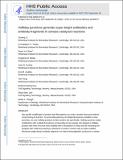| dc.contributor.author | Theile, Christopher S. | |
| dc.contributor.author | Chen, Guan-Yu | |
| dc.contributor.author | Bilate, Angelina M. | |
| dc.contributor.author | Duarte, Joao N. | |
| dc.contributor.author | Avalos, Ana M. | |
| dc.contributor.author | Fang, Tao | |
| dc.contributor.author | Barberena, Roberto | |
| dc.contributor.author | Sato, Shuji | |
| dc.contributor.author | Ploegh, Hidde | |
| dc.contributor.author | Li, Zeyang,S.M.Massachusetts Institute of Technology. | |
| dc.date.accessioned | 2017-05-01T18:47:33Z | |
| dc.date.available | 2017-05-01T18:47:33Z | |
| dc.date.issued | 2015-09 | |
| dc.date.submitted | 2015-07 | |
| dc.identifier.issn | 1433-7851 | |
| dc.identifier.issn | 1521-3773 | |
| dc.identifier.uri | http://hdl.handle.net/1721.1/108551 | |
| dc.description.abstract | The site-specific modification of proteins with fluorophores can render a protein fluorescent without compromising its function. To avoid self-quenching from multiple fluorophores installed in close proximity, we used Holliday junctions to label proteins site-specifically. Holliday junctions enable modification with multiple fluorophores at reasonably precise spacing. We designed a Holliday junction with three of its four arms modified with a fluorophore of choice and the remaining arm equipped with a dibenzocyclooctyne substituent to render it reactive with an azide-modified fluorescent single-domain antibody fragment or an intact immunoglobulin produced in a sortase-catalyzed reaction. These fluorescent Holliday junctions improve fluorescence yields for both single-domain and full-sized antibodies without deleterious effects on antigen binding. | en_US |
| dc.language.iso | en_US | |
| dc.publisher | Wiley Blackwell | en_US |
| dc.relation.isversionof | http://dx.doi.org/10.1002/anie.201505277 | en_US |
| dc.rights | Creative Commons Attribution-Noncommercial-Share Alike | en_US |
| dc.rights.uri | http://creativecommons.org/licenses/by-nc-sa/4.0/ | en_US |
| dc.source | PMC | en_US |
| dc.title | Fluorophore-Conjugated Holliday Junctions for Generating Super-Bright Antibodies and Antibody Fragments | en_US |
| dc.type | Article | en_US |
| dc.identifier.citation | Li, Zeyang et al. “Fluorophore-Conjugated Holliday Junctions for Generating Super-Bright Antibodies and Antibody Fragments.” Angewandte Chemie International Edition 54.40 (2015): 11706–11710. | en_US |
| dc.contributor.department | Massachusetts Institute of Technology. Department of Biology | en_US |
| dc.contributor.department | Whitehead Institute for Biomedical Research | en_US |
| dc.contributor.mitauthor | Ploegh, Hidde | |
| dc.relation.journal | Angewandte Chemie International Edition | en_US |
| dc.eprint.version | Author's final manuscript | en_US |
| dc.type.uri | http://purl.org/eprint/type/JournalArticle | en_US |
| eprint.status | http://purl.org/eprint/status/PeerReviewed | en_US |
| dspace.orderedauthors | Li, Zeyang; Theile, Christopher S.; Chen, Guan-Yu; Bilate, Angelina M.; Duarte, Joao N.; Avalos, Ana M.; Fang, Tao; Barberena, Roberto; Sato, Shuji; Ploegh, Hidde L. | en_US |
| dspace.embargo.terms | N | en_US |
| dc.identifier.orcid | https://orcid.org/0000-0002-1090-6071 | |
| mit.license | OPEN_ACCESS_POLICY | en_US |
